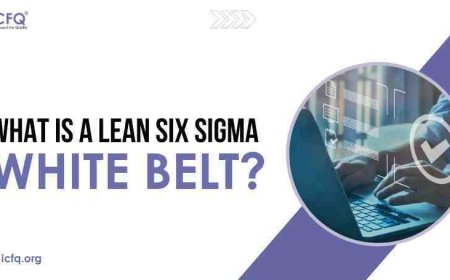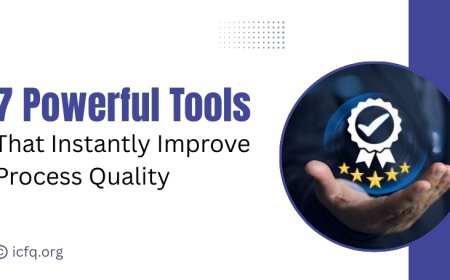How to Achieve Six Sigma Certification Online
Learn how to get Six Sigma Certification online with our easy guide. Find the steps, best courses, and tips to improve your skills and boost your career.

Six Sigma is a methodology focused on improving business processes by reducing variability and defects. It uses a data-driven approach and tools like DMAIC (Define, Measure, Analyze, Improve, Control) to optimize operations and enhance product quality. This systematic method not only helps in identifying the root causes of inefficiencies but also provides effective solutions to eliminate them, ensuring better consistency and reliability in business outputs.
The pursuit of Six Sigma certification online offers convenience and flexibility, allowing individuals and teams to access training from anywhere at any time. This accessibility makes it easier for professionals to adapt their learning to their schedules and needs, supporting continuous professional development without disrupting their current job responsibilities. Online certification in Six Civil provides a practical pathway for enhancing skills and advancing careers in process improvement.
Key Features of Top Online Six Sigma Programs
When selecting top online Six Sigma programs, consider these key features:
-
Accreditation and Recognition: It's important to choose programs that are accredited, as this ensures the program meets set standards and is recognized by employers and professionals in the industry. Accreditation helps in maintaining professional credibility.
-
Comprehensive Curriculum: The program should cover all the essential Six Sigma principles and their practical applications. A thorough curriculum ensures that you learn both the theory and how to apply it in real-world situations.
-
Interactive Learning Tools: Effective online programs use modern learning tools like virtual simulations, interactive quizzes, and projects that reflect real-world scenarios. These tools help make learning engaging and applicable to practical experiences.
These features are crucial for ensuring that the program provides valuable learning that can be effectively applied in professional settings.
Why Choose Online Certification?
Choosing online certification, particularly for methodologies like Six Sigma, presents several advantages compared to traditional in-person training formats. Here's a detailed look at these benefits and how they compare:
Advantages of Online Learning
1. Flexibility: Online certification programs allow learners to access materials and attend sessions from anywhere, eliminating the need for commuting or adhering to a rigid class schedule. This flexibility is particularly beneficial for professionals who need to balance learning with work and personal commitments.
2. Self-Paced Learning: One of the significant advantages of online learning is the ability to progress at one's own pace. Learners can spend more time on complex topics and less on those they grasp quickly, which can enhance understanding and retention of information.
3. Access to Diverse Resources: Online programs often provide a wealth of learning materials, including videos, lectures, readings, and interactive tools, which are not always available in a traditional classroom setting. Additionally, online platforms frequently update their resources to reflect the latest developments and best practices in the field.

4. Interaction: Traditional in-person training often offers direct interaction with instructors and peers, which can enhance learning through discussions and immediate feedback. While online programs may seem to lack this, many now incorporate forums, live webinars, and group projects to simulate a classroom environment and encourage interaction.
5. Hands-On Experience: In-person training can provide hands-on experiences in real-time, which is especially useful in fields requiring practical skills. Online training attempts to replicate this through simulations, virtual labs, and real-world projects, though the experience may not be as immersive as in-person scenarios.
6. Cost-Effectiveness: Online courses generally cost less than traditional programs due to lower overhead costs for the providers (no physical space requirements, fewer materials, etc.). Additionally, learners save on commuting and possibly accommodation costs, making it a more economical option overall.
7. Learning Environment: Traditional settings benefit from a structured environment, which can help learners stay motivated and disciplined. Online learning, however, requires a higher degree of self-motivation and discipline, as the home environment offers more distractions.
Overall, online certification offers significant advantages in terms of flexibility, pace, and access to diverse learning resources, making it an attractive option for many professionals. While it does pose some challenges in terms of interaction and hands-on experience, advancements in online education technology are continually bridging these gaps. For those seeking convenience and comprehensive learning opportunities, online certification is an excellent choice.
Six Sigma certifications are tiered to match different levels of expertise and career aspirations. Each level builds upon the previous, offering more advanced skills and responsibilities.
Types of Six Sigma Certifications
-
Yellow Belt: This certification provides a basic introduction to the Six Sigma methodology and lays the foundation for further learning. It's ideal for those who are new to process improvement and need a broad understanding of the Six Sigma principles. Suitable for those looking to understand the basics of Six Sigma and contribute to projects as part of a team.
-
Green Belt: This level focuses on intermediate skills, including project management and data analysis. Green Belt certification is suited for individuals who manage small to medium-scale projects and require a deeper understanding of the Six Sigma process. Ideal for professionals who lead smaller projects and focus on tactical improvements within their specific areas of expertise.
-
Black Belt: This certification involves advanced analytical skills and leadership training. Black Belts are expected to lead large projects and provide coaching to Green Belts. It is ideal for professionals aiming to play a significant role in business strategy and operational excellence. Aimed at individuals aspiring to lead multiple projects and play a key role in shaping process strategy within their organizations.
-
Master Black Belt: This highest level of Six Sigma certification focuses on strategic implementation and mentorship. Master Black Belts are leaders who guide Black Belts and drive major initiatives across their organization. They also act as mentors to other Six Sigma practitioners. Best for seasoned professionals who seek to influence organizational change at the highest levels and mentor other Six Sigma practitioners.
Choosing the right Six Sigma certification depends on one’s current role and career aspirations. Each level equips individuals with the necessary tools to contribute effectively to their organization's process improvement efforts.
Overcoming Six Sigma Certification Barriers
Professionals aiming for Six Sigma certification can face challenges, but here are straightforward ways to overcome them:
1. Manage Time: Set a clear schedule for study times and break learning into small parts to make it manageable alongside daily responsibilities.
2. Handle Costs: Six Sigma courses can be pricey. Look for employer sponsorship, payment plans, or scholarships to help with expenses.
3. Find Resources: Ensure your program provides comprehensive learning materials and support. Use online forums and study groups to enhance your understanding.
4. Choose the Right Program: Pick a program that fits your career goals and is accredited. Compare different programs to see which one offers the best fit for your needs.
5. Stay Motivated: Set clear goals and regularly remind yourself why you want this certification. Joining a network of learners can also help keep you motivated.
Pursuing Six Sigma certification online is convenient because you can learn from anywhere and at your speed, which is great for busy people. This certification teaches important skills for improving processes and managing quality effectively. Having a Six Sigma certification can help professionals do better in their jobs and make their organizations run more smoothly. Overall, this certification is good for personal career growth and for helping the whole organization.




























